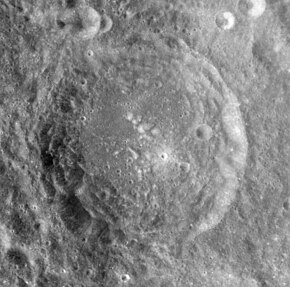Marconi (crater)
 Apollo 17 mapping camera image | |
| Coordinates | 9°29′S 145°12′E / 9.48°S 145.20°E |
|---|---|
| Diameter | 72.88 km |
| Depth | Unknown |
| Colongitude | 215° at sunrise |
| Eponym | Guglielmo Marconi |


Marconi is a lunar impact crater that is located on the Moon's far side. It lies to the northwest of the large walled plain Gagarin, and to the southwest of the prominent crater Chaplygin. To the west-northwest of Marconi is the slightly larger Dellinger.
This is a well-formed crater with only some modest impact erosion that has softened the features. The outer rim is marked only by a few tiny craterlets and some terrace structures can still be seen along the inner walls. There is a pair of small craterlets along the inner wall to the south and east. Near the midpoint of the relatively level interior floor is a low central rise composed of several small hills. The floor is otherwise marked by a number of tiny craterlets.
The crater was named after Italian physicist, inventor, and Nobel laureate Guglielmo Marconi by the IAU in 1970.[1] The crater was known as Crater 295 prior to naming.[2]
Satellite craters
[edit]By convention these features are identified on lunar maps by placing the letter on the side of the crater midpoint that is closest to Marconi.
| Marconi | Latitude | Longitude | Diameter |
|---|---|---|---|
| C | 8.4° S | 146.8° E | 9 km |
| H | 11.0° S | 147.5° E | 41 km |
| L | 11.7° S | 145.3° E | 38 km |
| S | 10.0° S | 143.1° E | 14 km |
See also
[edit]- 1332 Marconia, asteroid
References
[edit]- ^ Marconi, Gazetteer of Planetary Nomenclature, International Astronomical Union (IAU) Working Group for Planetary System Nomenclature (WGPSN)
- ^ Lunar Farside Chart (LFC-1A)
- Andersson, L. E.; Whitaker, E. A. (1982). NASA Catalogue of Lunar Nomenclature. NASA RP-1097.
- Blue, Jennifer (July 25, 2007). "Gazetteer of Planetary Nomenclature". USGS. Retrieved 2007-08-05.
- Bussey, B.; Spudis, P. (2004). The Clementine Atlas of the Moon. New York: Cambridge University Press. ISBN 978-0-521-81528-4.
- Cocks, Elijah E.; Cocks, Josiah C. (1995). Who's Who on the Moon: A Biographical Dictionary of Lunar Nomenclature. Tudor Publishers. ISBN 978-0-936389-27-1.
- McDowell, Jonathan (July 15, 2007). "Lunar Nomenclature". Jonathan's Space Report. Retrieved 2007-10-24.
- Menzel, D. H.; Minnaert, M.; Levin, B.; Dollfus, A.; Bell, B. (1971). "Report on Lunar Nomenclature by the Working Group of Commission 17 of the IAU". Space Science Reviews. 12 (2): 136–186. Bibcode:1971SSRv...12..136M. doi:10.1007/BF00171763. S2CID 122125855.
- Moore, Patrick (2001). On the Moon. Sterling Publishing Co. ISBN 978-0-304-35469-6.
- Price, Fred W. (1988). The Moon Observer's Handbook. Cambridge University Press. ISBN 978-0-521-33500-3.
- Rükl, Antonín (1990). Atlas of the Moon. Kalmbach Books. ISBN 978-0-913135-17-4.
- Webb, Rev. T. W. (1962). Celestial Objects for Common Telescopes (6th revised ed.). Dover. ISBN 978-0-486-20917-3.
- Whitaker, Ewen A. (1999). Mapping and Naming the Moon. Cambridge University Press. ISBN 978-0-521-62248-6.
- Wlasuk, Peter T. (2000). Observing the Moon. Springer. ISBN 978-1-85233-193-1.
